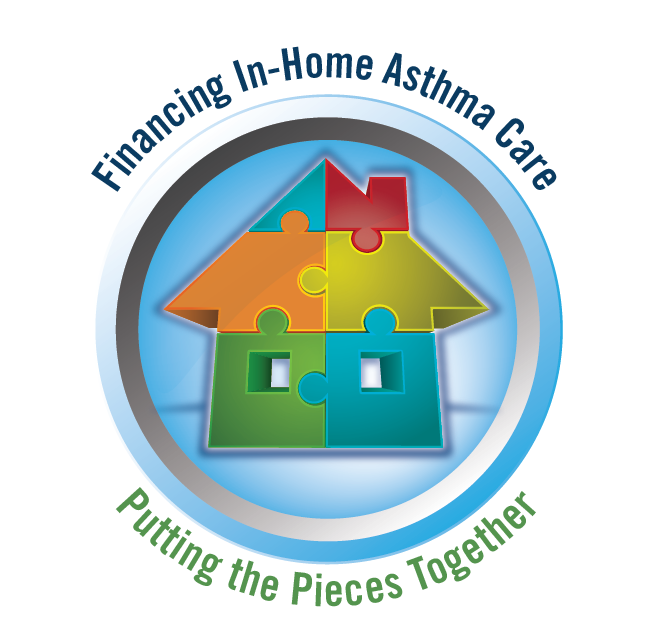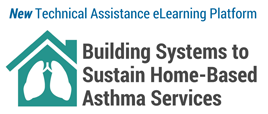Understanding Sustainable Financing Options

Sustainable financing for in-home asthma care may come from multiple sources, both short-term, such as grants, and long-term, sustainable streams, such as health care reimbursement. Bringing multiple streams of funding together to cover the full spectrum of in-home asthma care is often referred to as "braided funding." Healthcare funding, particularly Medicaid reimbursement, and housing funding streams are often braided together to support multi-disciplinary in-home care—where, for example, Medicaid pays for disease education while housing funds pay for structural remediation. New funding streams, like social impact financing, are also being used as supplemental funding to cover costs outside of healthcare and housing's reach.
Braided Funding
Braided funding refers to the use of multiple funding streams to pay for a variety of in-home asthma care services—ranging from education alone to education, assessment and
 structural remediation—with careful accounting of how each dollar from each stream is spent. The concept of "braiding" conveys that though funding streams are separate, in-home asthma care programs often braid them together to pay for more services than any one stream can support on its own, and then carefully track the expenditures to report back to funders on how their money was spent. The illustration here represents ways that funding for home-based asthma care services can be combined to cover critical in-home asthma care needs. In addition to combining funding sources, also consider emerging social impact financing and partnering with state or county health, housing or environmental programs to integrate in-home asthma care in their operations.
structural remediation—with careful accounting of how each dollar from each stream is spent. The concept of "braiding" conveys that though funding streams are separate, in-home asthma care programs often braid them together to pay for more services than any one stream can support on its own, and then carefully track the expenditures to report back to funders on how their money was spent. The illustration here represents ways that funding for home-based asthma care services can be combined to cover critical in-home asthma care needs. In addition to combining funding sources, also consider emerging social impact financing and partnering with state or county health, housing or environmental programs to integrate in-home asthma care in their operations.
Medicaid Financing
NCHH provides training and technical assistance on Medicaid reimbursement and other financing: Visit NCHH’s website to learn more about financing options through Medicaid and other sources through resources like: Medicaid 101:What You Need to Know, Pathways to Reimbursement:Understanding the Expanding Medicaid Services in Your State, Social Impact Bonds, Hospital Community Benefits and more.
Commonwealth Fund Report: The Affordable Care Act
In 2015, the Commonwealth Fund published several features to examine how, after five years, the Affordable Care Act (ACA) is meeting its aim of achieving quality, affordable health care for all Americans. A multi-media piece looks at various ACA initiatives related to reimbursement system reform to improve care quality and contain costs. Topics covered include Accountable Care Organizations (ACOs), Paying for Value, and Strengthening Primary Care. The stories and payment innovations described may offer opportunities for in-home asthma care.
Medicaid – A Primer: Key Information on the Nation's Health Coverage Program for Low-Income People
Kaiser Family Foundation, 2013.
The primer report examines how the Medicaid program is structured, who it covers, what services it provides, how it is financed and how much it costs. It also provides an overview of how Medicaid will change under the health reform law.
Webinar: Medicaid 101: What You Need to Know
The Alliance for Health Reform and the Kaiser Family Foundation, 2013.
This webinar briefing presents the basics of Medicaid and its role in the health care system. Speakers address questions on how the program is administered, how much it costs and how it is financed, as well as how the Affordable Care Act affects the program and what states are doing to transform Medicaid to meet current and future needs of its beneficiaries.
Questions & Answers on Medicaid & Community-based Asthma Interventions: Recent Changes & Future Steps
Childhood Asthma Leadership Coalition, 2014.
This one-page document explains recent changes in Medicaid regulations regarding which types of providers can be reimbursed for providing preventive services to Medicaid and CHIP beneficiaries.
A Case Study in Payment Reform to Support Optimal Pediatric Asthma Care
The Brookings Institution, 2015.
This case study explores the role of emerging payment models in supporting care redesign for patients with poorly controlled pediatric asthma.
Can We Reduce Childhood Asthma and Lower Costs, Too?
The Brookings Institution, 2014.
In this brief web article, the challenge and opportunity of addressing asthma is presented succinctly. The medical system is set up to treat illness, not necessarily to improve health. Health payers, such as Medicaid and private insurance, are used to paying for traditional medical services—often very expensive ones, such as ED treatment or hospitals stays— but not for less expensive non-medical services, such as parent education, home inspections, and cleaning supplies.
Webinar: Practical Strategies for Integrating Clinical and Community Asthma Innovation with Sustainable Payment
Webinar, May 4, 2015.
This webinar focused on a successful community intervention deployed by the St. Louis chapter of the AAFA. Speakers discussed payment and policy options currently being tested by the Center for Medicaid and Children's Health Insurance Program (CHIP) Services and other agencies, assessed challenges and opportunities for innovation, and provided practical strategies and next steps for integrating sustainable payment and system transformation.
Medicaid Funding of Community-Based Prevention Myths, State Successes Overcoming Barriers and the Promise of Integrated Payment Models
The Nemours Health System, 2013.
This report presents key myths about Medicaid financing of community-based prevention, and state examples that debunk these myths. Some states have demonstrated success in navigating Medicaid rules to finance prevention initiatives and have been very adept at using Medicaid as part of a braided funding stream to support broad health goals.
Webinar: Practical Strategies for Integrating Clinical and Community Asthma Innovation with Sustainable Payment
The Brookings Institution, 2015. This webinar focuses on successful community intervention deployed in the St. Louis chapter of the Asthma and Allergy Foundation of America. Speakers discuss payment and policy options currently being tested by the Center for Medicaid and Children's Health Insurance Program Services and other agencies.
Health Plan Financing
The Value of In-Home Interventions: Health Plan Perspective
Mary Cooley, Priority Health
Cindy Cookson, Neighborhood Health Plan
This PowerPoint provides an overview of the benefits to health plans of a comprehensive asthma management program.
Social Impact Financing
Podcast: What Is a Social Impact Bond, and Why Does Asthma Present a Good Fit for This Innovative Financing Mechanism?
Ruth Ann Norton, Green & Healthy Homes Initiative, 2015.
Learn about Pay for Success and Social Impact Financing and steps you can take to ready your program for these opportunities. GHHI President and CEO Ruth Ann Norton says, "Asthma is one of the best opportunities to have a real and true successful outcome in terms of repayment and actual change in policy and impact to communities under the Pay for Success model."
Housing Financing
Affordable Housing’s Place in Health Care Opportunities Created by the Affordable Care Act and Medicaid Reform
Center for Housing Policy, 2015
This report examines several ways in which health care changes created by the ACA, and other health care reform initiatives, create the potential for affordable housing providers to collaborate with health care providers, insurers, and other institutions to support the wellbeing of low-income individuals and families.
More Resources
AsthmaCommunityNetwork.org Publication Spotlight: Commonwealth Fund on Five Years of ACA & Reimbursement Changes

Review why sustainable financing is important and consider mechanisms for putting sustainable financing of home-based asthma services in place. Learn more at Building Systems to Sustain Home-Based Asthma Services—Overview of Sustainable Financing.

